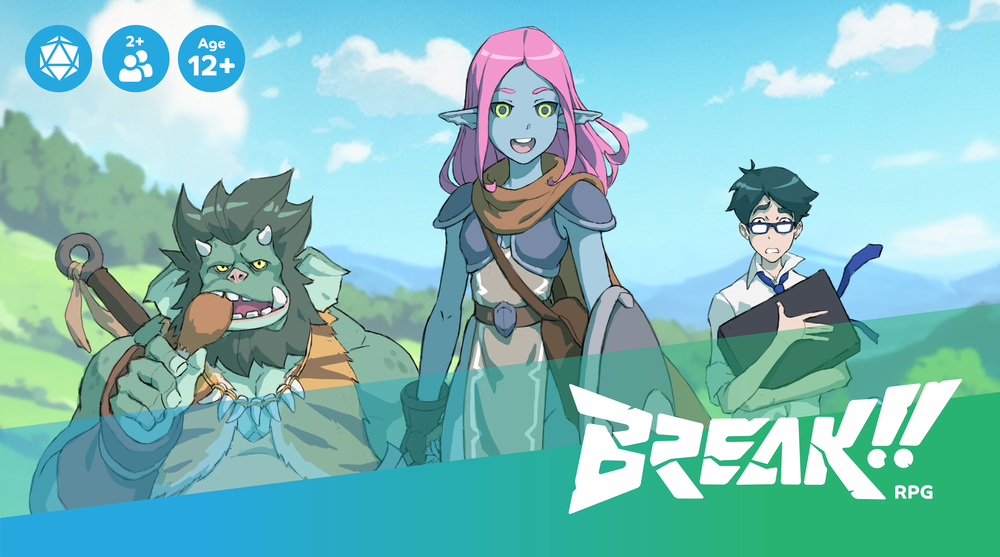Time Keeping in the timeless world of BREAK!!
I just love BREAK!!.
If you haven’t been navigating the OSR spheres (OSpheRes?) at all in the last ten years, there is a small chance you haven’t heard of BREAK!!. This tabletop roleplaying game is a love letter to classic JRPG and anime that builds on old-school D&D to deliver a fresh take on the tired old elfgame. What makes it work so well for me is that it is serious, but also not.
Granted, seriously-but-also-not is the way I run every dee-endee, but the whimsical and anachronistic vibe in Outer World (the game’s setting) gels super well with the heroic-yet-deadly mechanics. Much better than anything I’ve ever seen.
 Grey Wizard’s art is just 👩🍳👌😘
Grey Wizard’s art is just 👩🍳👌😘
But anyway. One of the specificities of Outer World is that its sun (or to be exact, the Sun Machine) doesn’t revolve around the planet. The machine was broken long ago, and for eons it has been hovering above one of the continents. This gives distinct atmospheres and themes to regions depending where they are relative to the unmoving star, which is a genius idea. And as a GM, it also makes me think about how communities keep track of time. The book (or Reynaldo on the BREAK!! Discord — my brain doesn’t remember things anymore) says that people are more chilled in Outer World because they aren’t slaves to clocks or bells like they are in Other World (that’s our world, or a version of it). Which is another great worldbuilding detail.
Playing an NPC in my first session though, I found myself stumped when a length of time needed to be stated. “The search party is leaving tomor… er, in the morn… er, at first ligh… at Third Bell!” is more or less what I ended up saying. I could have said “When we’re all awake”, but that’s not what came out. I just made a mental note to answer the time-keeping question when I prep a settlement.
Hence the following table.
The time-keeping method here (d20)
- None. People don’t care about anyone’s need for sleep. People around here a always a bit on edge.
- None, but people have a system of signals (signs on doors, flags, hats on pegs…) to indicate when they’re resting.
- Marked candles are used by families and work groups to tell when the next activity or sleep cycle (“lights”) happens. Not in a coordinated way though.
- People have a natural sense of time. Their sleep and activity cycles are very short. (Like a one-hour nap every two hours.)
- Everyone gets to be in charge of keeping time for a week. They ring a gong at intervals that feel right to them. People associate according to their views on timekeeping and work cycles.
- The locals model their sleep cycles on the prides or roarclaws who live around here. They snack and nap a lot.
- A colony of honeycrawls living among the villagers provides them with a strict schedule.
- The flowers of the starchid tree open and close at regular intervals. Different species have different schedules, and people and communities choose the flowers that suit their personalities.
- A goblin inventor maintains a network of cogs and cables connecting lumi-slime jars. Tiny hammers and pop guns awake some slimes every handful of hours. The number of illuminated jars marks the time of the day.
- Bells are rung six times a day by local monks. The intervals follow meditation cycles and are simply called “bells”.
- The nearby volcano spouts harmless fireworks three times a day. People call these periods flames (morning), flares (afternoon), and fumes (night).
- A gigantic clocktower powered by an ancient arcane source. It has 21 hours. The last one is the Witching Hour, when ambiant mana surges.
- An old clepsydre is painstakingly kept in working order inside a temple-workshop. The shaolingineers who live there raise a different flag every two hours (13 flags total).
- People use glowing mana-rocks to tell time. These stones have a colour cycle, with colder hues being used as resting time. Only thing is, the proximity of mana disrupts the cycle. And adventurers bring a lot of mana with them.
- An antique warbot has been dying under the town for as long as anyone can remember. A loud buzzing alarm resonates four times a day. These four cycles are called “throes”.
- The synthaur (a bio-mechanoid with the lower body of a largzard) who serves as the militia captain has an internal clock. They loudly announce every hour. Even at night.
- Luminous dronekites are seen dancing high in the sky for about half the day. People are superstitiously afraid of them, so they stay indoors to rest and sleep when they are visible.
- An oldtech clock network is maintained by a clan of rai-nekos. The digital clocks are connected to each other by radio waves. They may even have a radio station with a morning DJ.
- The settlement owns one or more SMT clocks, plugged into the outer-world-wide Standard Merchant Time arcane network. (Thanks Burn!)
- There are two concurrent and possibly competing time keeping systems. Roll again twice.
 This is how I envision the clocks of entry 18
This is how I envision the clocks of entry 18
Note: with no objective way to measure days, some activity cycles will be much shorter than others. One community’s day may last an objective 16 hours when the next one’s is closer to 28 hours. Does it matter? Only if you have a human stray who brought a Swiss wristwatch with them, I guess.